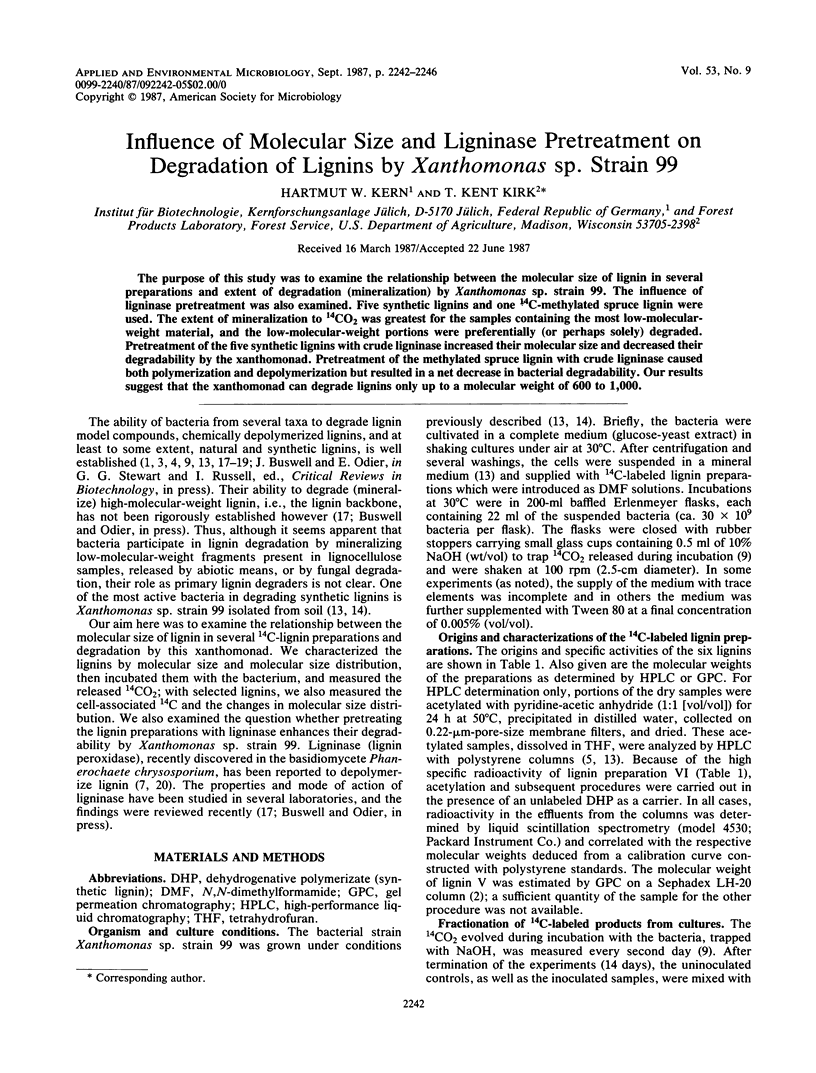Abstract
The purpose of this study was to examine the relationship between the molecular size of lignin in several preparations and extent of degradation (mineralization) by Xanthomonas sp. strain 99. The influence of ligninase pretreatment was also examined. Five synthetic lignins and one 14C-methylated spruce lignin were used. The extent of mineralization to 14CO2 was greatest for the samples containing the most low-molecular-weight material, and the low-molecular-weight portions were preferentially (or perhaps solely) degraded. Pretreatment of the five synthetic lignins with crude ligninase increased their molecular size and decreased their degradability by the xanthomonad. Pretreatment of the methylated spruce lignin with crude ligninase caused both polymerization and depolymerization but resulted in a net decrease in bacterial degradability. Our results suggest that the xanthomonad can degrade lignins only up to a molecular weight of 600 to 1,000.
Full text
PDF




Selected References
These references are in PubMed. This may not be the complete list of references from this article.
- Glenn J. K., Morgan M. A., Mayfield M. B., Kuwahara M., Gold M. H. An extracellular H2O2-requiring enzyme preparation involved in lignin biodegradation by the white rot basidiomycete Phanerochaete chrysosporium. Biochem Biophys Res Commun. 1983 Aug 12;114(3):1077–1083. doi: 10.1016/0006-291x(83)90672-1. [DOI] [PubMed] [Google Scholar]
- Haider K., Trojanowski J., Sundman V. Screening for lignin degrading bacteria by means of 14C-labelled lignins. Arch Microbiol. 1978 Oct 4;119(1):103–106. doi: 10.1007/BF00407936. [DOI] [PubMed] [Google Scholar]
- Jäger A., Croan S., Kirk T. K. Production of Ligninases and Degradation of Lignin in Agitated Submerged Cultures of Phanerochaete chrysosporium. Appl Environ Microbiol. 1985 Nov;50(5):1274–1278. doi: 10.1128/aem.50.5.1274-1278.1985. [DOI] [PMC free article] [PubMed] [Google Scholar]
- Kern H. W. Bacterial degradation of dehydropolymers of coniferyl alcohol. Arch Microbiol. 1984 May;138(1):18–25. doi: 10.1007/BF00425401. [DOI] [PubMed] [Google Scholar]
- Keyser P., Kirk T. K., Zeikus J. G. Ligninolytic enzyme system of Phanaerochaete chrysosporium: synthesized in the absence of lignin in response to nitrogen starvation. J Bacteriol. 1978 Sep;135(3):790–797. doi: 10.1128/jb.135.3.790-797.1978. [DOI] [PMC free article] [PubMed] [Google Scholar]
- Kirk T. K., Farrell R. L. Enzymatic "combustion": the microbial degradation of lignin. Annu Rev Microbiol. 1987;41:465–505. doi: 10.1146/annurev.mi.41.100187.002341. [DOI] [PubMed] [Google Scholar]
- Tien M., Kirk T. K. Lignin-Degrading Enzyme from the Hymenomycete Phanerochaete chrysosporium Burds. Science. 1983 Aug 12;221(4611):661–663. doi: 10.1126/science.221.4611.661. [DOI] [PubMed] [Google Scholar]


